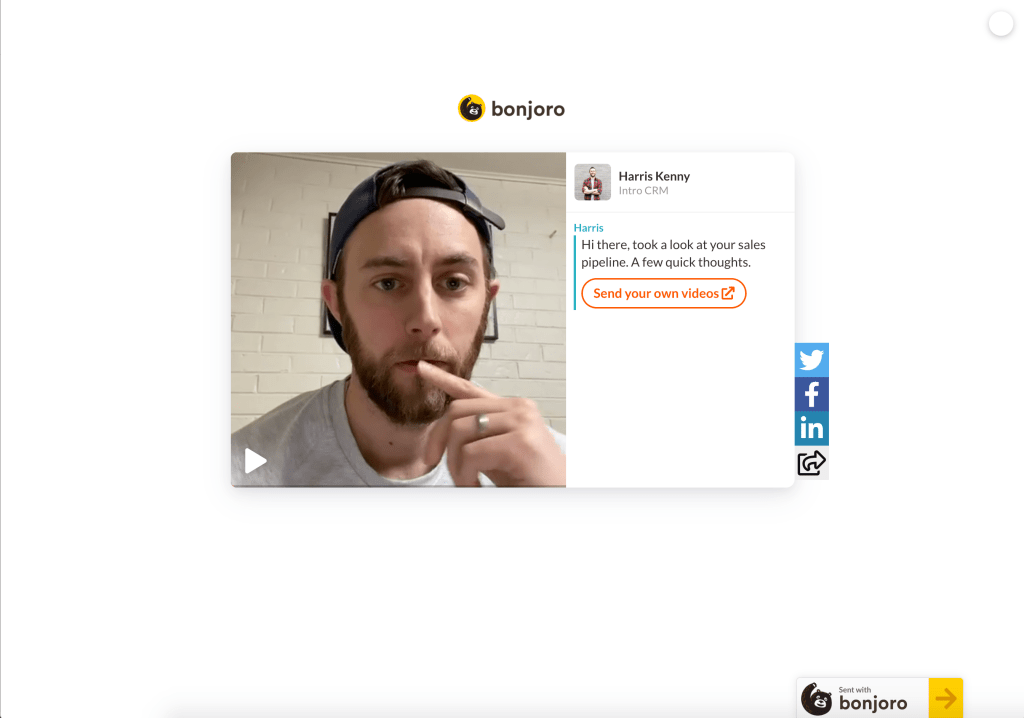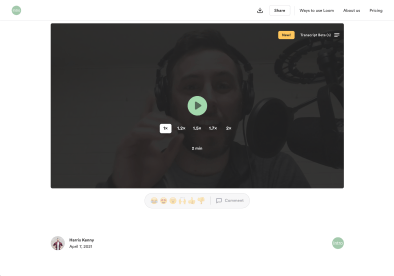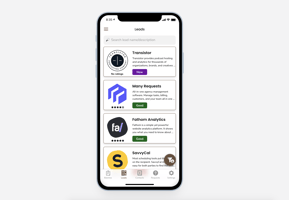We’re so excited for the upcoming months here at Intro CRM. We want to take some time to give you a...
8 Helpful Tips on Video for Inbound Sales in 2021
So many people talk about wanting to run a “passive income” business but the reality is that practically every company takes work to run. This is especially true when it comes to new customer onboarding. No matter how you do it, the tone is set at the beginning. In this post, we will explore how we use video for inbound sales and onboarding here at Intro CRM.
Before we jump into the nitty-gritty of the results and our lessons learned about using video for inbound sales, let’s talk about what we did and why we did it. We decided to make personalized video for every single new Intro CRM signup.
Through this experiment, we were hoping to accomplish five things:
- Improve new user activation
- Make up for a lack of software onboarding
- Practice our messaging and positioning
- Get a sense of who our new users were
- Introduce ourselves to our customers
Further down in this post, we share a few bonus tips including: pronouncing names, how to think about projects like this in terms of sales funnels, video tools we used (Bonjoro vs. Loom), and finally whether it was worth using video for inbound sales—or not.
Now, you might not think of all these goals as being directly sales related, but these are new sign-ups who are in our sales funnel. So we are thinking about these as sales activation challenges.
Overview
If you’re like us, you enjoy making personal connections with your customers. If you had all the time in the world, you would sit down with each and every single one of them for four hours and learn everything you could about them. But, the reality is that you want to get to know your customers without overloading your schedule and without making it harder on them, either.
Chances are you have started brainstorming ideas and maybe, you’ve even landed on using video for inbound sales too, but how do you do it well? We ran an experiment, or 77 actually, and we have a few ideas… Let’s go!
Like you, we wanted to make the onboarding process for Intro CRM as seamless as possible. Before we could iron out all the kinks, we needed to get in the trenches and do some work.
We chose, and when rehabbing your sales funnel – we encourage you, to take a manual approach at first to ensure what we were building was actually going to solve the problem.
We wanted to ensure that our processes made life easier, not harder, and that they gave the right customers the right information. After that work was done, finding a way to efficiently automate the process was easy!

Here’s an example of the classic sales funnel, the AIDA model attributed to American advertising and sales pioneer E. St. Elmo Lewis.
Illustration shared under CC BY-SA 4.0 BronHiggs
Many different versions of the funnel concept have been developed. And the concept of a funnel is just one way to visualize your sales. There are many alternative mental models, like sales loops, flywheels, micro moments, and so on. That’s besides the point of this post!
1. Using Video for Inbound Sales to Improve New User Activation
One of our biggest goals for this experiment was to create a memorable impact early on to ensure that our users weren’t just signing up and forgetting about our software.
We knew our customers wouldn’t use it every single day, that’s not why we created it, we created Intro CRM to be a tool that integrates seamlessly with your task management software, like Basecamp, Trello, or Asana, but we wanted to make sure our users felt like they understood how to maximize our platform.
The results? Our impacts here were marginal, 57% of people watched, and we got great feedback, but we didn’t have a strong call to action. When we started, there wasn’t a clear call to action, more of a “reach out if you need help.”
After some feedback from a friend, we decided to send people to our SavvyCal link with the call to action being to book a call to finish onboarding. Few people took us up on booking a call and most of them did get into the software, but the impact here wasn’t as drastic as we imagined. Yes people watched, and we love speaking with customers but it wasn’t effective enough at driving action in the app.
2. Making Up for the Lack Of Software Onboarding
Arguably the biggest lesson we learned testing video for inbound sales is that you can’t replace, substitute, or jury rig a satisfactory software onboarding replacement.
There is no stand-in for good self-guided onboarding.
Intro CRM is so new that we’re focused on the product. We don’t have the built in workflows or new user wizards to help you explore every screen and step of the progress. For now, we have written documentation for things like integrations with project management tools, but many other features are still in development. We believe that creating the right UX for the right features is going to take time, and we’re here to make sure it gets done correctly.
We’re not in growth mode. We’re in building mode, which is why we wanted to use video for inbound sales as an onboarding asset to help sell the product. The concept of using these as assets is why we opted for Loom—to help actually show the produc—but we’ll talk more on the tools we used to pull these together later.
3. Practice our messaging and positioning
This was by fast the most tactical result of this experiment. We practiced our pitch 77 times. We kept it fast…think 90 seconds or less! The benefit of doing all these videos is that we were able to construct our own trade show experience.
We got real-time feedback on what was interesting, what people wanted to hear, and how they wanted to hear it, this quick feedback loop is what helped us get crystal clear on what we had to say in just a few months.
The discipline we’re taking away from this win is that people only care what you have to say if you’re talking about something they care about! Using video for inbound sales in this part of our funnel allowed us to connect personally and empathically with each customer.
4. Get a sense of who our new users were
We started this experiment with the goal being to manually discover tactical results we could act on. However, the results we found we couldn’t believe. Taking time to screen every new user allowed us to track spikes in sign ups from things like podcast appearances, MicroConf, Indie Hackers, etc.
Now that we have such great understanding of our users, it’s easier to tailor our messaging and ensure that we’re continuing to build and invest in a product that will be helpful to the people using it.
We now have a subset of data that would be hard to get if we hadn’t taken the time to explore this process manually, we’re not saying you have to use video in sales, but it’s worth considering.
5. Introduce ourselves to our customers
Running a software company, it can be challenging to find creative ways to introduce ourselves to our customers beyond email or a text message. We want to put a name to the face! When we opted to use video for inbound sales, we knew it could put us in a vulnerable position, but hey so is starting a company.
Turns out, being vulnerable with our customers brought nothing but positive feedback from people who appreciated our desire to incorporate human touch into a tech company.
We learned a little bit more than we originally expected, so next let’s talk about some easy best practices for video sales that helped the process go seamlessly from start to end.
Here Are A Few More Things We Learned
Name Pronunciation Matters (and it’s easy to get right!)
There are so many names, with so many pronunciations that were intimidating for us—we didn’t want to offend anyone.
Here’s our secret: Search is your friend!
Search “how to pronounce” followed by their name. This helps a ton, and we got compliments from people who appreciated the effort. Nailing names is a small thing that signals a high level of importance to the receivers.
Search engines with audio—like YouTube—can be especially helpful. Remember to keep in mind that there are regional dialects, accents, and different for languages.
Whether you are doing video for inbound sales, scheduling meetings with customers, conference calls, or anything else, we recommend this as a practice. And once you’ve connected with them, respectfully ask how to pronounce their name and this way you will know for sure that you’re getting it right.
The Best Way To Think? In Terms of Funnels
When we reframed these videos are funnels, we were able to maximize the impact each stage had. We had to curate the best subject line, thumbnail, title, opening line, etc.
To help these videos stand out, we decided to take a few extra steps to enhance the personal touch. We bought an MC Squares whiteboard and wrote the recipient’s name on it. It took a few extra minutes, but capturing this image and the thumbnail was the icing on the cake of personal touches to make a powerful funnel.
Picking the Right Tool for the Job (Bonjoro vs. Loom)
We started this process with Bonjoro. It’s a neat tool from an indie company, and they have many powerful integrations. With complex triggers it’s easy to stay top of mind with a tool like this, automation comes easy.
However, for our purposes, we wanted to maximize this face-to-screen interaction and help supplement for the lack of software onboarding we have in place, so we moved to Loom when recording video for inbound sales.
We like how Loom has the picture-in-picture option, and the recording software is pretty robust. It’s an easy way to tangibly take someone on a tour of the software while simultaneously getting to know them. These are just two. There are many others—like Vidyard—just be sure to pick one that works for you.
Here’s a clean side-by-side look at what prospective customers see with each tool:


Is Using Video for Inbound Sales Worth It?
Okay, let’s wrap up! Here’s our final assessment…
Was it easy? Mostly, but it was more work than we initially thought it would be.
Was it worth using video for inbound sales? Yes, so far, we have been pleased with the results and feel like it’s an investment worth making in our company.
Will we keep making them? Yes, for the foreseeable future, we plan on making them. So, sign up today and get to know us!
Do we recommend you doing something like this? Yes, we think it’s worth a try. The reality is that you can’t replace a robust onboarding process, but you don’t have to settle for a loose customer relationship when that’s the case.
Take the risk, get to know your people, and don’t forget, we’re here to help! We can help you design an intentional and easy customer onboarding process that allows you to focus on your people without wanting to pull your hair out.
If you’re interested in more tips that you can use as a founder or just responsible for go to market strategy, consider signing up for the Intro CRM newsletter.

